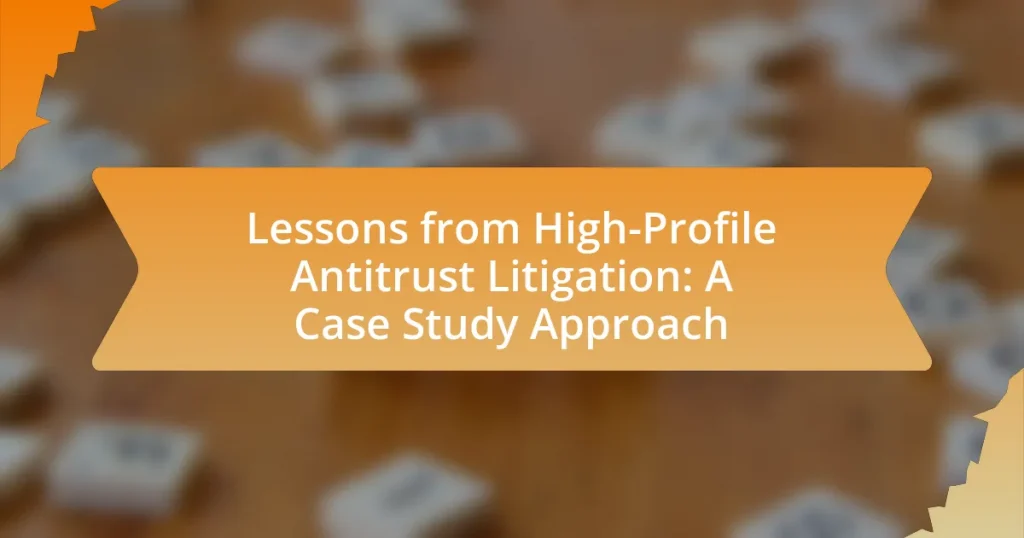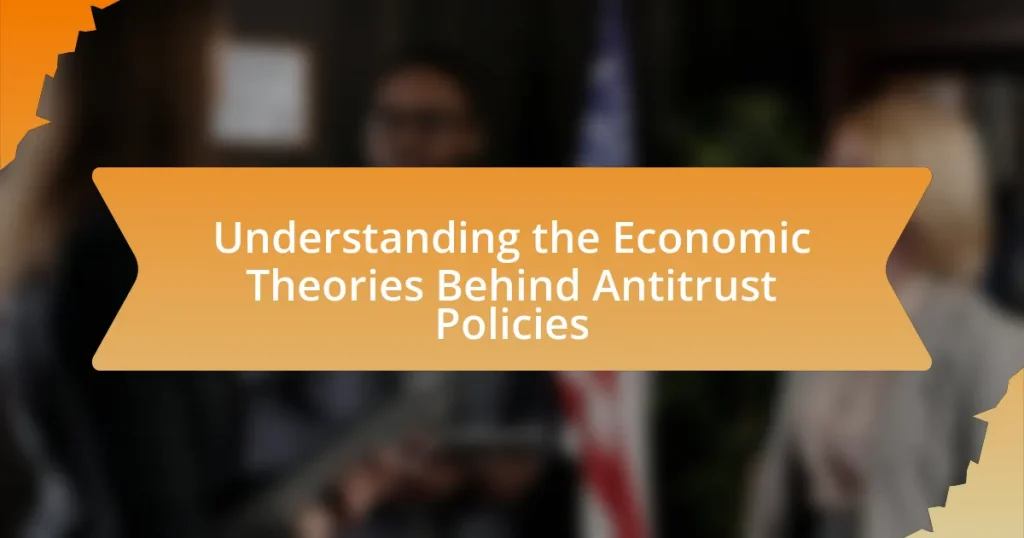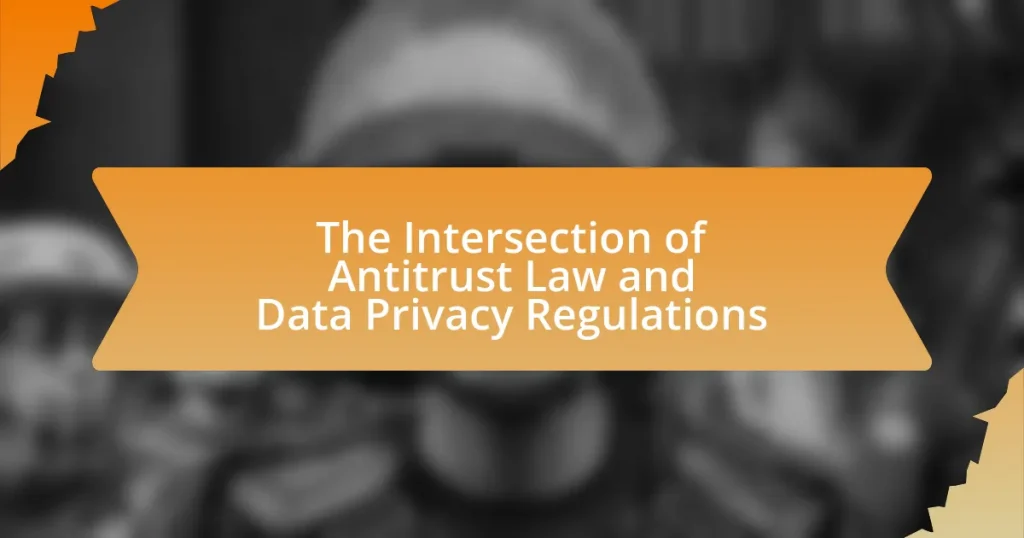The article focuses on the key lessons derived from high-profile antitrust litigation, emphasizing the significance of thorough market analysis, clear evidence of anti-competitive behavior, and the influence of public perception on legal outcomes. It examines how landmark cases, such as United States v. Microsoft and the European Commission’s case against Google, have shaped future antitrust cases by establishing legal precedents and influencing regulatory strategies. Additionally, the article highlights the challenges faced in antitrust litigation, the role of economic theories, and the strategies companies can adopt to navigate these complex legal landscapes effectively. Through a case study approach, the article provides insights into the implications of notable antitrust cases on corporate practices and regulatory frameworks.
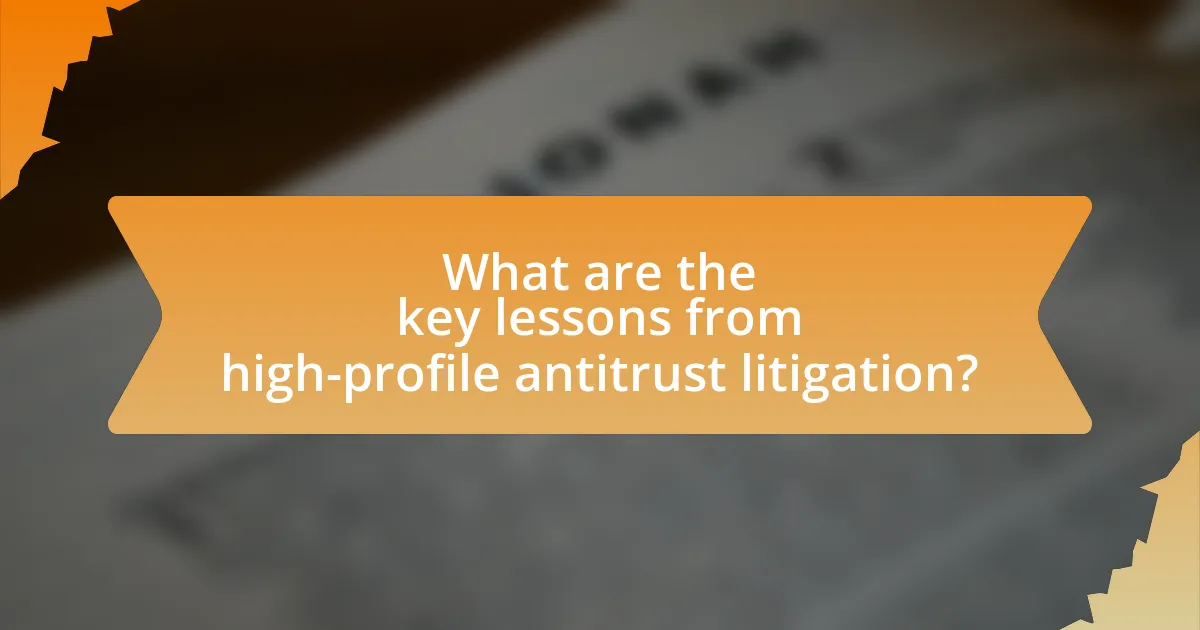
What are the key lessons from high-profile antitrust litigation?
Key lessons from high-profile antitrust litigation include the importance of thorough market analysis, the necessity of clear evidence of anti-competitive behavior, and the impact of public perception on legal outcomes. Thorough market analysis, as seen in the United States v. Microsoft case, demonstrated that understanding market dynamics is crucial for establishing monopolistic practices. Clear evidence of anti-competitive behavior was pivotal in the European Commission’s case against Google, where specific practices were scrutinized to prove harm to competition. Additionally, public perception played a significant role in shaping the narrative and outcomes of cases, as illustrated by the backlash against large tech companies, influencing regulatory scrutiny and legal strategies.
How do these lessons impact future antitrust cases?
Lessons from high-profile antitrust litigation significantly shape future antitrust cases by establishing precedents that guide legal interpretations and enforcement strategies. For instance, the outcomes of landmark cases like United States v. Microsoft have clarified the standards for assessing monopolistic behavior, influencing how courts evaluate market dominance and anti-competitive practices. These established legal frameworks enable regulators and legal practitioners to better navigate complex market dynamics, ensuring that future cases are approached with a clearer understanding of acceptable business conduct and the potential consequences of anti-competitive actions.
What specific outcomes have emerged from notable antitrust cases?
Notable antitrust cases have led to significant outcomes, including substantial fines, changes in corporate practices, and the breakup of monopolistic entities. For instance, the U.S. v. Microsoft case resulted in Microsoft being required to share its application programming interfaces with third-party developers, which fostered competition in the software market. Additionally, the European Commission’s antitrust ruling against Google in 2017 imposed a record €2.42 billion fine for favoring its own shopping service in search results, prompting changes in how search algorithms are managed. These outcomes illustrate the enforcement of antitrust laws aimed at promoting fair competition and protecting consumer interests.
How do these outcomes influence legal strategies in antitrust litigation?
Outcomes in antitrust litigation significantly influence legal strategies by shaping the approach attorneys take in future cases. For instance, successful defenses against antitrust claims often lead to a greater emphasis on demonstrating pro-competitive effects and efficiencies in subsequent litigation. Additionally, high-profile cases, such as the United States v. Microsoft Corp., have established precedents that guide legal arguments and strategies, prompting firms to adopt more aggressive compliance measures and risk assessments to avoid similar scrutiny. These outcomes also inform settlement strategies, as parties may weigh the likelihood of success based on past rulings and the evolving legal landscape, ultimately leading to more calculated decisions in negotiations.
Why is a case study approach valuable in understanding antitrust litigation?
A case study approach is valuable in understanding antitrust litigation because it provides in-depth insights into specific legal cases, illustrating the complexities and nuances of antitrust laws in practice. This method allows for the examination of real-world scenarios, revealing how various factors such as market dynamics, regulatory responses, and competitive behaviors influence legal outcomes. For instance, analyzing landmark cases like United States v. Microsoft Corporation demonstrates how the application of antitrust principles can vary based on the context, leading to different interpretations and enforcement actions. Such detailed examinations enhance comprehension of legal precedents and inform future litigation strategies, making the case study approach essential for grasping the intricacies of antitrust law.
What are the advantages of analyzing specific cases?
Analyzing specific cases provides targeted insights that enhance understanding of complex legal frameworks and outcomes. This approach allows for the examination of unique circumstances, strategies, and judicial reasoning that can inform future litigation and policy decisions. For instance, studying high-profile antitrust cases, such as the United States v. Microsoft Corp., reveals how market dominance and competitive practices are evaluated, offering valuable lessons on regulatory enforcement and corporate behavior. Such case analyses contribute to the development of best practices and legal precedents, ultimately shaping the landscape of antitrust law.
How can case studies reveal patterns in antitrust enforcement?
Case studies can reveal patterns in antitrust enforcement by providing detailed analyses of specific legal cases, illustrating how regulatory bodies interpret and apply antitrust laws. For instance, examining landmark cases such as United States v. Microsoft Corporation demonstrates how the enforcement of antitrust laws adapts to technological advancements and market dynamics. These case studies highlight recurring themes, such as the criteria used to assess market dominance and the impact of mergers on competition. By analyzing multiple cases, researchers can identify trends in judicial reasoning, regulatory priorities, and the effectiveness of enforcement actions, thereby offering insights into the evolving landscape of antitrust policy.
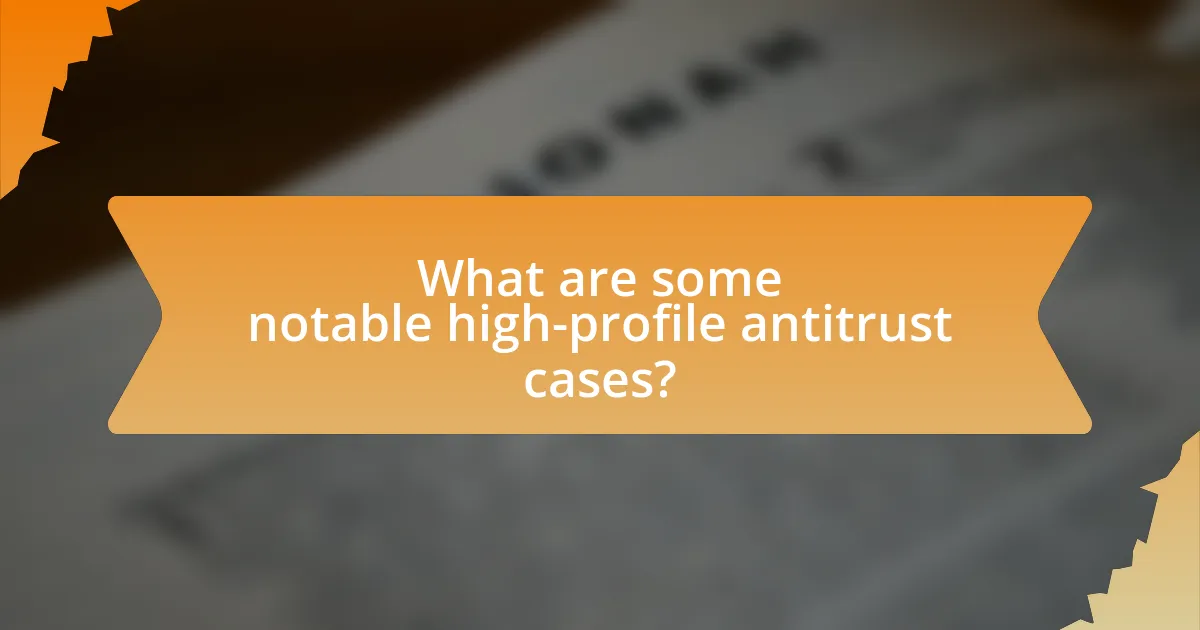
What are some notable high-profile antitrust cases?
Notable high-profile antitrust cases include the United States v. Microsoft Corporation, which addressed monopolistic practices in the software market, and the United States v. AT&T Inc., which focused on the merger of telecommunications giants. In the Microsoft case, the company was found to have engaged in anti-competitive behavior by bundling its Internet Explorer browser with the Windows operating system, leading to a landmark ruling in 2000 that imposed restrictions on its business practices. The AT&T case, resolved in 1982, resulted in the breakup of the Bell System, which had monopolized telephone service in the U.S. These cases exemplify significant government interventions aimed at promoting competition and preventing monopolistic behavior in key industries.
How did these cases shape antitrust law and policy?
High-profile antitrust cases have significantly shaped antitrust law and policy by establishing legal precedents and clarifying the application of antitrust principles. For instance, the United States v. Microsoft Corp. case in the late 1990s reinforced the importance of market dominance and the implications of anti-competitive practices, leading to stricter scrutiny of monopolistic behavior. Additionally, the 2018 case against AT&T’s acquisition of Time Warner highlighted the evolving interpretation of vertical mergers, influencing regulatory approaches to future mergers and acquisitions. These cases have prompted lawmakers and regulators to refine antitrust statutes, ensuring they address contemporary market dynamics and technological advancements.
What were the main arguments presented in these cases?
The main arguments presented in high-profile antitrust litigation cases typically revolve around market dominance, anti-competitive practices, and consumer harm. For instance, in the case of United States v. Microsoft Corp., the government argued that Microsoft engaged in anti-competitive behavior by bundling its Internet Explorer browser with its Windows operating system, thereby stifling competition and harming consumers. Similarly, in the case of United States v. Google LLC, the Department of Justice contended that Google’s practices in search and advertising markets constituted monopolistic behavior that limited competition and innovation. These arguments are supported by evidence of market share data, consumer impact assessments, and expert testimonies that illustrate the negative effects of such practices on competition and consumer choice.
What were the judicial outcomes and their implications?
The judicial outcomes of high-profile antitrust litigation often result in significant changes to corporate practices and regulatory frameworks. For instance, in the landmark case of United States v. Microsoft Corp., the court’s ruling led to the imposition of structural remedies, including the separation of certain business units, which aimed to foster competition in the software market. This outcome not only reshaped Microsoft’s business operations but also set a precedent for how antitrust laws could be applied to technology companies, influencing future litigation and regulatory scrutiny in the tech sector. The implications of such outcomes extend beyond individual cases, as they can lead to increased enforcement of antitrust laws, greater scrutiny of mergers and acquisitions, and a shift in corporate behavior towards compliance with competitive practices.
What role do economic theories play in antitrust litigation?
Economic theories play a critical role in antitrust litigation by providing frameworks to analyze market behavior and assess competitive practices. These theories help courts and regulators determine whether business practices harm competition or consumers, often relying on concepts such as market power, price elasticity, and consumer welfare. For instance, the Chicago School of Economics emphasizes that market forces typically self-correct, suggesting that only practices that significantly harm consumer welfare should be scrutinized. Conversely, the Post-Chicago approach considers the complexities of market dynamics, arguing that certain behaviors, like predatory pricing, can be anti-competitive even if they do not immediately harm consumers. Empirical evidence, such as the outcomes of landmark cases like United States v. Microsoft Corp., illustrates how economic theories inform judicial reasoning and regulatory decisions, ultimately shaping the enforcement of antitrust laws.
How do economic principles influence case outcomes?
Economic principles significantly influence case outcomes by shaping the legal arguments and the interpretation of market behavior in antitrust litigation. For instance, concepts such as market power, consumer welfare, and competitive effects guide courts in assessing whether a company’s actions harm competition. In the landmark case of United States v. Microsoft Corp., economic analysis was pivotal; the court evaluated Microsoft’s market dominance and its impact on consumer choice, ultimately leading to a ruling that emphasized the importance of maintaining competitive markets. This demonstrates that economic principles not only inform legal standards but also directly affect judicial decisions and remedies in antitrust cases.
What are the criticisms of applying economic theories in antitrust cases?
The criticisms of applying economic theories in antitrust cases include their oversimplification of complex market dynamics and reliance on assumptions that may not hold true in real-world scenarios. Critics argue that economic models often fail to account for non-economic factors such as consumer behavior, market structure, and the potential for innovation. For instance, the Chicago School of thought, which emphasizes efficiency and consumer welfare, has been criticized for neglecting the anti-competitive effects of monopolistic practices. Additionally, empirical evidence may be misinterpreted or selectively used to support predetermined conclusions, leading to flawed legal outcomes. These criticisms highlight the limitations of economic theories in capturing the multifaceted nature of competition and market power.
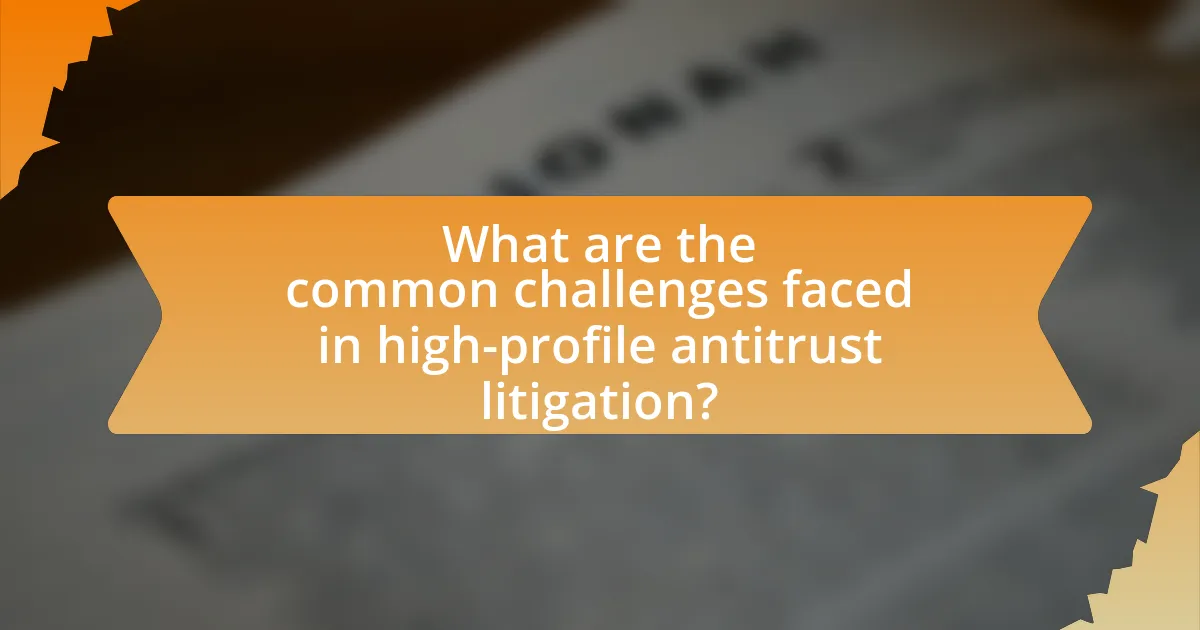
What are the common challenges faced in high-profile antitrust litigation?
High-profile antitrust litigation commonly faces challenges such as complex legal frameworks, extensive discovery processes, and the need for expert economic testimony. The complexity arises from the intricate nature of antitrust laws, which require a deep understanding of market dynamics and competitive practices. Extensive discovery processes can lead to significant delays and increased costs, as parties must sift through vast amounts of data and documents. Additionally, the reliance on expert economic testimony is crucial, as courts often require specialized knowledge to interpret market behavior and assess competitive effects, which can complicate the litigation process. These challenges are evidenced by cases like United States v. Microsoft Corp., where the legal intricacies and expert testimonies played pivotal roles in the outcome.
How do these challenges affect the litigation process?
Challenges in high-profile antitrust litigation significantly complicate the litigation process by increasing the duration and complexity of cases. These challenges include extensive discovery demands, which can lead to delays as parties sift through vast amounts of data, and the need for expert testimony, which often requires additional time for preparation and presentation. For instance, in the United States v. Microsoft case, the extensive discovery process contributed to a protracted litigation timeline, lasting several years. Additionally, the high stakes involved can lead to aggressive legal strategies, further complicating negotiations and settlement discussions. These factors collectively result in increased legal costs and resource allocation, ultimately affecting the efficiency and outcomes of the litigation process.
What are the most frequent legal hurdles encountered?
The most frequent legal hurdles encountered in high-profile antitrust litigation include proving anti-competitive behavior, navigating complex regulatory frameworks, and addressing challenges related to market definition. These hurdles arise because plaintiffs must provide substantial evidence that a company’s actions significantly harm competition, which often requires extensive economic analysis and expert testimony. Additionally, the legal landscape is shaped by varying interpretations of antitrust laws across jurisdictions, complicating compliance and litigation strategies. For instance, the Sherman Act and the Clayton Act in the United States impose different standards for assessing anti-competitive conduct, leading to potential legal ambiguities that can hinder case progression.
How do defendants typically respond to antitrust allegations?
Defendants typically respond to antitrust allegations by denying the claims and asserting that their business practices are lawful and pro-competitive. They often argue that their actions do not violate antitrust laws, citing legal precedents and economic theories that support their position. For instance, in high-profile cases, defendants may present evidence demonstrating that their conduct leads to lower prices or increased innovation, which are beneficial to consumers. Additionally, they may seek to dismiss the case through motions or negotiate settlements to avoid prolonged litigation, as seen in various antitrust cases where companies opted for settlements to mitigate legal risks and costs.
What strategies can be employed to navigate antitrust litigation effectively?
To navigate antitrust litigation effectively, companies should employ a combination of proactive compliance measures, thorough legal preparation, and strategic communication. Proactive compliance involves establishing robust antitrust compliance programs that educate employees about legal standards and promote adherence to competition laws. Thorough legal preparation includes conducting internal audits to identify potential antitrust risks and engaging experienced legal counsel to develop a strong defense strategy. Strategic communication entails maintaining transparency with stakeholders and the public to manage perceptions and mitigate reputational damage. These strategies are supported by historical cases, such as the U.S. v. Microsoft Corp., where proactive compliance and effective legal strategies played crucial roles in the outcome of the litigation.
What best practices should legal teams adopt in preparation for antitrust cases?
Legal teams should adopt a proactive approach by conducting thorough internal audits and compliance assessments in preparation for antitrust cases. This involves reviewing business practices, pricing strategies, and market behavior to identify potential antitrust risks. Historical cases, such as the United States v. Microsoft Corp., highlight the importance of documenting business decisions and maintaining clear communication among team members to ensure compliance with antitrust laws. Additionally, legal teams should engage in continuous training on antitrust regulations and collaborate with economic experts to analyze market dynamics, which can provide valuable insights during litigation.
How can companies mitigate risks associated with antitrust litigation?
Companies can mitigate risks associated with antitrust litigation by implementing robust compliance programs and conducting regular antitrust training for employees. These measures help ensure that employees understand antitrust laws and the company’s policies, reducing the likelihood of violations. For instance, a study by the American Bar Association found that companies with comprehensive compliance programs are less likely to face antitrust investigations. Additionally, companies should engage in regular audits of their business practices to identify and rectify potential antitrust issues proactively. This proactive approach not only minimizes legal exposure but also fosters a culture of compliance within the organization.
What practical insights can be drawn from high-profile antitrust litigation?
High-profile antitrust litigation reveals critical insights into market dynamics and regulatory frameworks. These cases often highlight the importance of competitive practices, demonstrating how monopolistic behaviors can stifle innovation and harm consumers. For instance, the U.S. v. Microsoft case in the late 1990s illustrated the consequences of anti-competitive practices, leading to increased scrutiny of tech giants and shaping future regulatory approaches. Additionally, these litigations underscore the necessity for companies to maintain compliance with antitrust laws to avoid significant legal repercussions and financial penalties, as seen in the European Union’s actions against Google, which resulted in fines exceeding €8 billion. Such cases serve as cautionary tales, emphasizing the need for transparency and fair competition in the marketplace.
